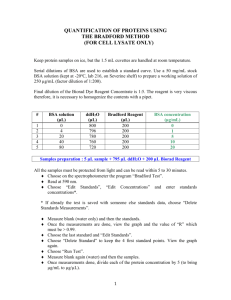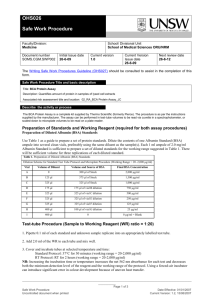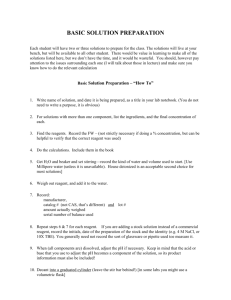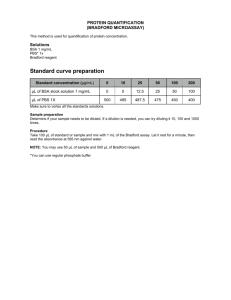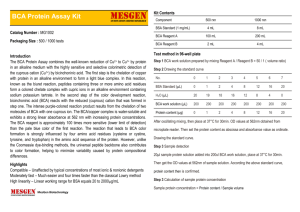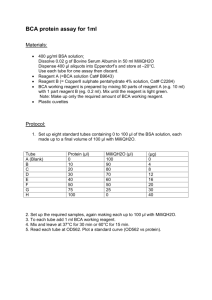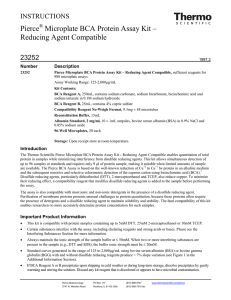BCA Protein Assay Kit II
advertisement
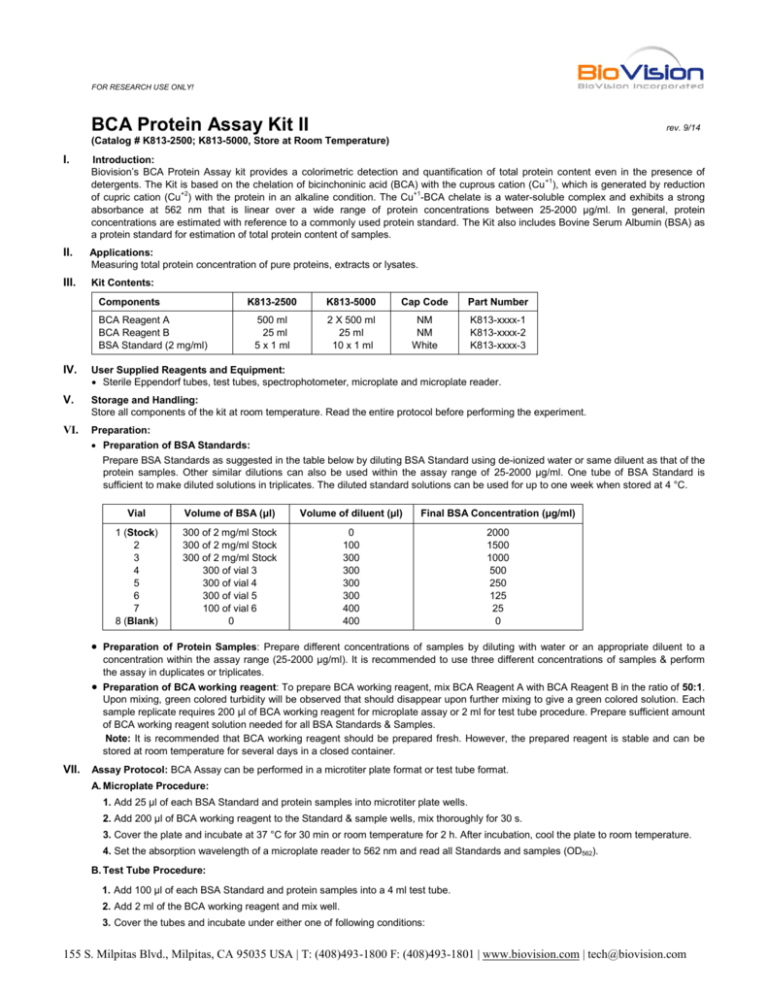
FOR RESEARCH USE ONLY! BCA Protein Assay Kit II rev. 9/14 (Catalog # K813-2500; K813-5000, Store at Room Temperature) I. Introduction: Biovision’s BCA Protein Assay kit provides a colorimetric detection and quantification of total protein content even in the presence of detergents. The Kit is based on the chelation of bicinchoninic acid (BCA) with the cuprous cation (Cu +1), which is generated by reduction of cupric cation (Cu+2) with the protein in an alkaline condition. The Cu+1-BCA chelate is a water-soluble complex and exhibits a strong absorbance at 562 nm that is linear over a wide range of protein concentrations between 25-2000 μg/ml. In general, protein concentrations are estimated with reference to a commonly used protein standard. The Kit also includes Bovine Serum Albumin (BSA) as a protein standard for estimation of total protein content of samples. II. Applications: Measuring total protein concentration of pure proteins, extracts or lysates. III. Kit Contents: Components BCA Reagent A BCA Reagent B BSA Standard (2 mg/ml) K813-2500 K813-5000 Cap Code Part Number 500 ml 25 ml 5 x 1 ml 2 X 500 ml 25 ml 10 x 1 ml NM NM White K813-xxxx-1 K813-xxxx-2 K813-xxxx-3 IV. User Supplied Reagents and Equipment: Sterile Eppendorf tubes, test tubes, spectrophotometer, microplate and microplate reader. V. Storage and Handling: Store all components of the kit at room temperature. Read the entire protocol before performing the experiment. VI. Preparation: Preparation of BSA Standards: Prepare BSA Standards as suggested in the table below by diluting BSA Standard using de-ionized water or same diluent as that of the protein samples. Other similar dilutions can also be used within the assay range of 25-2000 μg/ml. One tube of BSA Standard is sufficient to make diluted solutions in triplicates. The diluted standard solutions can be used for up to one week when stored at 4 °C. Vial Volume of BSA (μl) Volume of diluent (μl) Final BSA Concentration (μg/ml) 1 (Stock) 2 3 4 5 6 7 8 (Blank) 300 of 2 mg/ml Stock 300 of 2 mg/ml Stock 300 of 2 mg/ml Stock 300 of vial 3 300 of vial 4 300 of vial 5 100 of vial 6 0 0 100 300 300 300 300 400 400 2000 1500 1000 500 250 125 25 0 Preparation of Protein Samples: Prepare different concentrations of samples by diluting with water or an appropriate diluent to a VII. concentration within the assay range (25-2000 µg/ml). It is recommended to use three different concentrations of samples & perform the assay in duplicates or triplicates. Preparation of BCA working reagent: To prepare BCA working reagent, mix BCA Reagent A with BCA Reagent B in the ratio of 50:1. Upon mixing, green colored turbidity will be observed that should disappear upon further mixing to give a green colored solution. Each sample replicate requires 200 μl of BCA working reagent for microplate assay or 2 ml for test tube procedure. Prepare sufficient amount of BCA working reagent solution needed for all BSA Standards & Samples. Note: It is recommended that BCA working reagent should be prepared fresh. However, the prepared reagent is stable and can be stored at room temperature for several days in a closed container. Assay Protocol: BCA Assay can be performed in a microtiter plate format or test tube format. A. Microplate Procedure: 1. Add 25 µl of each BSA Standard and protein samples into microtiter plate wells. 2. Add 200 µl of BCA working reagent to the Standard & sample wells, mix thoroughly for 30 s. 3. Cover the plate and incubate at 37 °C for 30 min or room temperature for 2 h. After incubation, cool the plate to room temperature. 4. Set the absorption wavelength of a microplate reader to 562 nm and read all Standards and samples (OD562). B. Test Tube Procedure: 1. Add 100 µl of each BSA Standard and protein samples into a 4 ml test tube. 2. Add 2 ml of the BCA working reagent and mix well. 3. Cover the tubes and incubate under either one of following conditions: 155 S. Milpitas Blvd., Milpitas, CA 95035 USA | T: (408)493-1800 F: (408)493-1801 | www.biovision.com | tech@biovision.com FOR RESEARCH USE ONLY! - 37 °C for 30 min or at room temperature for 2 h (Assay range is 25-2000 µg/ml) - 60 °C for 30 min (Assay range is 5-250 µg/ml) 4. After incubation, cool the tubes to room temperature. 5. Set the absorbance wavelength of a spectrophotometer to 562 nm. Blank the instrument by using water or the diluent only. 6. Read absorbance (OD562) of all Standards and samples. C. Calculations: Subtract OD562 of Blank (0 Standard, #8) from all readings. Plot the Standard curve, OD562 (on Y-axis) vs Standard BSA concentration (on X-axis). Obtain the equation from the plot Y = aX + b. Use the obtained value of slope (a) to calculate protein concentration in samples. Where Y = OD562 of protein sample X = concentration of protein sample a = Slope of the BSA Standard curve b = Y-intercept of the Standard Curve D = Dilution factor of protein sample Alternatively, get the sample concentration from the Standard curve. Then calculate protein concentration in sample: C = DX 2.5 Cyt. C (Bovine Heart) BSA OD562 2 1.5 y = 0.00094x + 0.03708 1 0.5 y = 0.00069x + 0.05218 0 0 500 1000 1500 2000 Protein Concentration (μg/ml) Figure: Typical absorbance plots obtained for BSA and Cytochrome C from Bovine Heart (Cat. # 2120) using a microplate procedure (37°C for 30 min). VIII. RELATED PRODUCTS: EZLysTM Bacterial Protein Extraction Reagent (8001) EZLysTM Tissue Protein Extraction Reagent (8002) EZLysTM lysozyme, human (8005) Western Blot Substrate Kit (K820) Protein Carbonyl Content Assay Kit (K830) Protease inhibitor cocktails (K271, K272, K277, K278, K279) EZLysTM Yeast Protein Extraction Reagent (8003) EZLysTM Mammalian Protein Extraction Reagent (8004) Protein Quantitation kit (K810) BCA Protein Quantitation Kit (K812, K814) Protease & Phosphatase inhibitor cocktails (K283, K284) FOR RESEARCH USE ONLY! Not to be used on humans. 155 S. Milpitas Blvd., Milpitas, CA 95035 USA | T: (408)493-1800 F: (408)493-1801 | www.biovision.com | tech@biovision.com

